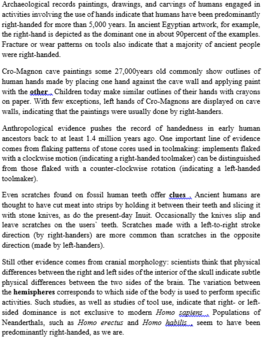Read the following passage and mark the letter A, B, C, or D on your answer sheet to indicate the correct answer to each of the questions from 36 to 42
In 1826, a Frenchman named Niépce needed pictures for his business. He was not a good artist, so he invented a very simple camera. He put it in a window of his house and took a picture of his yard. That was the first photograph.
The next important date in the history of photography was 1837. That year, Daguerre, another Frenchman, took a picture of his studio. He used a new kind of camera and a different process. In his pictures, you could see everything clearly, even the smallest details. This kind of photograph was called a daguerreotype.
Soon, other people began to use Daguerre's process. Travelers brought back daguerreotypes from all around the world. People photographed famous buildings, cities, and mountains.
In about 1840, the process was improved. Then photographers could take pictures of people and moving things. The process was not simple and photographers had to carry lots of film and processing equipment. However, this did not stop photographers, especially in the United States. After 1840, daguerreotype artists were popular in most cities.
Matthew Brady was one well-known American photographer. He took many portraits of famous people. The portraits were unusual because they were lifelike and full of personality. Brady was also the first person to take pictures of a war. His 1862 Civil War pictures showed dead soldiers and ruined cities. They made the war seem more real and more terrible.
In the 1880s, new inventions began to change photography. Photographers could buy film readymade in rolls, instead of having to make the film themselves. Also, they did not have to process the film immediately. They could bring it back to their studios and develop it later. They did not have to carry lots of equipment. And finally, the invention of the small handheld camera made photography less expensive.
With a small camera, anyone could be a photographer. People began to use cameras just for fun. They took pictures of their families, friends, and favorite places. They called these pictures "snapshots".
Documentary photographs became popular in newspapers in the 1890s. Soon magazines and books also used them. These pictures showed true events and people. They were much more real than drawings.
Some people began to think of photography as a form of art. They thought that photography could do more than show the real world. It could also show ideas and feelings, like other art forms. From “Reading Power” by Beatrice S. Mikulecky and Linda Jeffries
Which of the following could best serve as the title of the passage?
A. Different Steps in Film Processing
B. Story of Photography
C. Photography and Painting
D. Story of Famous Photographers








Đáp án B
Đáp án nào là tiêu đề hay nhất cho bài đọc?
A. Những bước khác nhau trong quá trình xử lý phim
B. Lịch sử của ngành nhiếp ảnh
C. Nhiếp ảnh và vẽ
D. Lịch sử của các nhiếp ảnh gia nổi tiếng